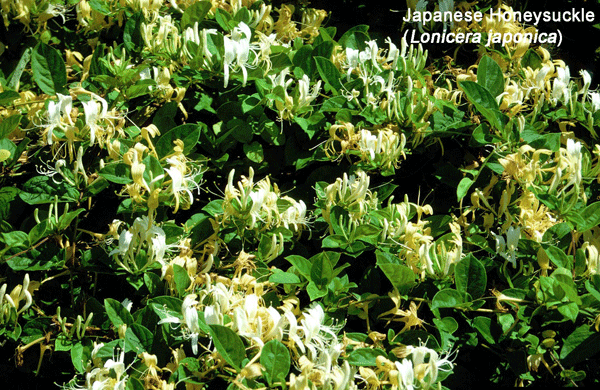
Originally introduced to the shores of Long Island, New York in 1806, the Japanese honeysuckle (Lonicera japonica) has become one of Maryland’s most evident invasive species to impact forests and wildlife. The Japanese honeysuckle is a woody vine adorned with fragrant white flowers and spreads by intertwining trees, overlaying bushes, and encompassing sections of Maryland’s forest floor (Maryland Invasive Species Council, 2005). Spreading over disturbed areas of land, roadsides, fields, and forests, the vine can survive in the colder winter months because of its semi-evergreen nature. Not only does the invasive vine block sunlight from trees and undergrowth, but it can also wrap tightly around trees, shrubs, and other natives, cutting off their nutrient supply and causing them to die (iNaturalist, 2023). Maryland’s forests depend on native pollinators, plants, and animals for survival, but through the introduction of invasives, there is heightened competition for space, food, and sunlight (Maryland Department of Natural Resources, 2023).
Maryland’s native biodiversity and forest integrity continues to be threatened by invasive species such as the Japanese honeysuckle so communities must take action to remove and cultivate the natural and native ecosystems. In terms of controlling the invasive spread, young vines can be uprooted to prevent further introduction to ecosystems, but all aspects of the plant (roots, seeds, runners) must be removed from the soil and trees to avoid new growth. Other methods of extermination include the use of foliar herbicides that can help eliminate extensive growth, but are most effective in the cooler months once native vegetation becomes dormant. Prescribed burns in the springtime can also help to slow the spread of the Japanese honeysuckle by burning the seeds and young growth (Evans, 2012). Communities can help slow the spread of this invasive species and are integral for maintaining the health and natural biodiversity of Maryland’s ecosystems.
Bibliography:
Evans, C. (2012). Japanese Honeysuckle.
iNaturalist. (2023). Japanese honeysuckle. INaturalist. https://www.inaturalist.org/guide_taxa/882857
Maryland Department of Natural Resources. (2023). Maryland Plants & Wildlife. Maryland Department of Natural Resources. https://dnr.maryland.gov/wildlife/Pages/default.aspx
Maryland Invasive Species Council. (2005). Japanese Honeysuckle. https://mdinvasives.org/iotm/nov-2005/
